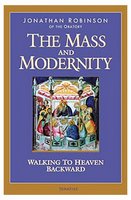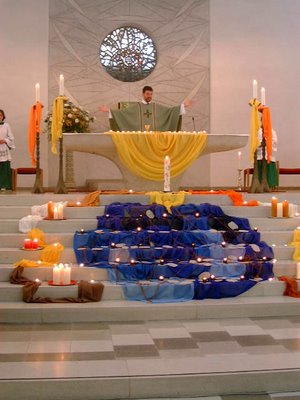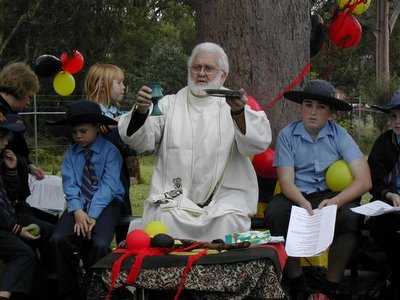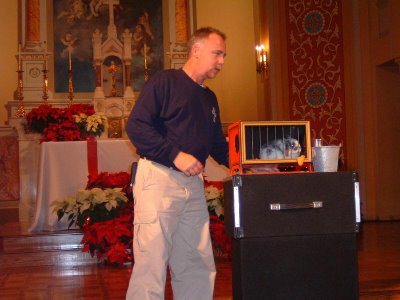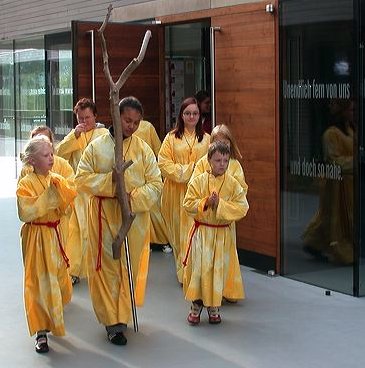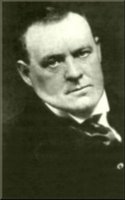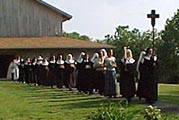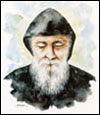If you have not read this before, take the time; I guarantee you will be enlightened as to how Ottaviani's fears have come to fruition.
Letter from Cardinals Ottaviani and Baccito His Holiness Pope Paul VI
(Translation)

Rome, September 25th, 1969
Most Holy Father,
Having carefully examined, and presented for the scrutiny of others, the Novus Ordo Missae prepared by the experts of the Consilium ad exequendam Constitutionem de Sacra Liturgia, and after lengthy prayer and reflection, we feel it to be our bounden duty in the sight of God and towards Your Holiness, to put before you the following considerations:
1. The accompanying critical study of the Novus Ordo Missae, the work of a group of theologians, liturgists and pastors of souls, shows quite clearly in spite of its brevity that if we consider the innovations implied or taken for granted which may of course be evaluated in different ways, the Novus Ordo represents, both as a whole and in its details, a striking departure from the Catholic theology of the Mass as it was formulated in Session XXII of the Council of Trent. The "canons" of the rite definitively fixed at that time provided an insurmountable barrier to any heresy directed against the integrity of the Mystery.
2. The pastoral reasons adduced to support such a grave break with tradition, even if such reasons could be regarded as holding good in the face of doctrinal considerations, do not seem to us sufficient. The innovations in the Novus Ordo and the fact that all that is of perennial value finds only a minor place, if it subsists at all, could well turn into a certainty the suspicions already prevalent, alas, in many circles, that truths which have always been believed by the Christian people, can be changed or ignored without infidelity to that sacred deposit of doctrine to which the Catholic faith is bound for ever. Recent reforms have amply demonstrated that fresh changes in the liturgy could lead to nothing but complete bewilderment on the part of the faithful who are already showing signs of restiveness and of an indubitable lessening of faith.
Amongst the best of the clergy the practical result is an agonising crisis of conscience of which innumerable instances come tour notice daily.
3. We are certain that these considerations, which can only reach Your Holiness by the living voice of both shepherds and flock, cannot but find an echo in Your paternal heart, always so profoundly solicitous for the spiritual needs of the children of the Church. It has always been the case that when a law meant for the good of subjects proves to be on the contrary harmful, those subjects have the right, nay the duty of asking with filial trust for the abrogation of that law.
Therefore we most earnestly beseech Your Holiness, at a time of such painful divisions and ever-increasing perils for the purity of the Faith and the unity of the church, lamented by You our common Father, not to deprive us of the possibility of continuing to have recourse to the fruitful integrity of that Missale Romanum of St. Pius V, so highly praised by Your Holiness and so deeply loved and venerated by the whole Catholic world.
A. Card. Ottaviani
A. Card. Bacci
- THE ACCOMPANYING STUDY -
BRIEF SUMMARY
The new form of Mass was substantially rejected by the Episcopal Synod, was never submitted to the collegial judgement of the Episcopal Conferences and was never asked for by the people. It has every possibility of satisfying the most modernist of Protestants.
II: Definition of the Mass.
By a series of equivocations the emphasis is obsessively placed upon the 'supper' and the 'memorial' instead of on the unbloody renewal of the Sacrifice of Calvary.
III: Presentation of the Ends.
The three ends of the Mass are altered:- no distinction is allowed to remain between Divine and human sacrifice; bread and wine are only "spiritually" (not substantially) changed.
IV:- and of the essence.
The Real Presence of Christ is never alluded to and belief in it is implicitly repudiated.
V:- and of the four elements of the sacrifice.
The position of both priest and people is falsified and the Celebrant appears as nothing more than a Protestant minister, while the true nature of the Church is intolerably misrepresented.
VI: The destruction of unity.
The abandonment of Latin sweeps away for good and all unity of worship. This may have its effect on unity of belief and the New Order has no intention of standing for the Faith as taught by the Council of Trent to which the Catholic conscience is bound.
VII: The alienation of the Orthodox.
While pleasing various dissenting groups, the New Order will alienate the East.
VIII: The abandonment of defences.
The New Order teems with insinuations or manifest errors against the purity of the Catholic religion and dismantles all defences of the deposit of Faith.
__________
I: HISTORY OF THE CHANGE
In October 1967, the Episcopal Synod called in Rome was required to pass judgement on the experimental celebration of a so-called "normative Mass" (New Mass), devised by the Consilium ad exsequendam Constitutionem de Sacra Liturgia. This Mass aroused the most serious misgivings. The voting showed considerable opposition (43 non placet), very many substantial reservations (62 juxta modum), and 4 abstentions out of 187 voters. The international press spoke of a "refusal" of the proposed "normative Mass" (New Mass) on the part of the Synod. Progressively-inclined papers made no mention of it.
In the Novus Ordo Missae lately promulgated by the Apostolic Constitution Missale Romanum, we once again find this "normative Mass" (New Mass), identical in substance, nor does it appear that in the intervening period the Episcopal Conference, at least as such, were ever asked to give their views about it.
In the Apostolic Constitution, it is stated that the ancient Missal promulgated by St. Pius V, 13th July 1570, but going back in great part to St. Gregory the Great and still remoter antiquity, was for four centuries the norm for the celebration of the Holy Sacrifice for priests of the Latin rite, and that, taken to every part of the world, "it has moreover been an abundant source of spiritual nourishment to many holy people in their devotion to God". Yet, the present reform, putting it definitely out of use, was claimed to be necessary since "from that time the study of the Sacred Liturgy has become more widespread and intensive among Christians".
This assertion seems to us to embody a serious equivocation. For the desire of the people was expressed, if at all, when - thanks to Pius X - they began to discover the true and everlasting treasures of the liturgy. The people never on any account asked for the liturgy to be changed, or mutilated so as to understand it better. They asked for a better understanding of the changeless liturgy, and one which they would never have wanted changed.
The Roman Missal of St. Pius V was religiously venerated and most dear to Catholics, both priests and laity. One fails to see how its use, together with suitable catechesis, could have hindered a fuller participation in, and great knowledge of the Sacred Liturgy, nor why, when its many outstanding virtues are recognised, this should not have been considered worthy to continue to foster the liturgical piety of Christians.
REJECTED BY SYNOD Since the "normative" Mass (New Mass), now reintroduced and imposed as the Novus Ordo Missae (New Order of the Mass), was in substance rejected by the Synod of Bishops, was never submitted to the collegial judgement of the Episcopal Conferences, nor have the people - least of all in mission lands - ever asked for any reform of Holy Mass whatsoever, one fails to comprehend the motives behind the new legislation which overthrows a tradition unchanged in the Church since the 4th and 5th centuries, as the Apostolic Constitution itself acknowledges. As no popular demand exists to support this reform, it appears devoid of any logical grounds to justify it and makes it acceptable to the Catholic people.
The Vatican Council did indeed express a desire (para. 50 Constitution Sacrosanctum Concilium) for the various parts of the Mass to be reordered "ut singularum partium propria ratio nec non mutua connexio clarius pateant." We shall see how the Ordo recently promulgated corresponds with this original intention.
An attentive examination of the Novus Ordo reveals changes of such magnitude as to justify in themselves the judgement already made with regard to the "normative" Mass. Both have in many points every possibility of satisfying the most Modernists of Protestants.
__________
II: DEFINITION OF THE MASS
Let us begin with the definition of the Mass given in No. 7 of the "Institutio Generalis" at the beginning of the second chapter on the Novus Ordo: "De structura Missae":
"The Lord's Supper or Mass is a sacred meeting or assembly of the People of God, met together under the presidency of the priest, to celebrate the memorial of the Lord. Thus the promise of Christ, "where two or three are gathered together in my name, there am I in the midst of them", is eminently true of the local community in the Church (Mt. XVIII, 20)".
The definition of the Mass is thus limited to that of the "supper", and this term is found constantly repeated (nos. 8, 48, 55d, 56). This supper is further characterised as an assembly presided over by the priest and held as a memorial of the Lord, recalling what He did on the first Maundy Thursday. None of this in the very least implies either the Real Presence, or the reality of sacrifice, or the Sacramental function of the consecrating priest, or the intrinsic value of the Eucharistic Sacrifice independently of the people's presence. It does not, in a word, imply any of the essential dogmatic values of the Mass which together provide its true definition. Here, the deliberate omission of these dogmatic values amounts to their having been superseded and therefore, at least in practice, to their denial.
In the second part of this paragraph 7 it is asserted, aggravating the already serious equivocation, that there holds good, "eminently", for this assembly Christ's promise that "Where two or three are gathered together in my name, there am I in the midst of them" (Matt. XVIII, 20). This promise which refers only to the spiritual presence of Christ with His grace, is thus put on the same qualitative plane, save for the greater intensity, as the substantial and physical reality of the Sacramental Eucharistic Presence.
In no. 8 a subdivision of the Mass into "liturgy of the word" and Eucharistic liturgy immediately follows, with the affirmation that in the Mass is made ready "the table of the God's word" as of "the Body of Christ", so that the faithful "may be built up and refreshed"; an altogether improper assimilation of the two parts of the liturgy, as though between two points of equal symbol value. More will be said about this point later.
This Mass is designed by a great many different expressions, all acceptable relatively, all unacceptable if employed, as they are, separately in an absolute sense.
We cite a few: The Action of the People of God; The Lord's Supper or Mass, the Pascal Banquet; The Common Participation of the Lord's Table; The Eucharistic Prayer; The Liturgy of the Word and the Eucharistic Liturgy.
As is only too evident, the emphasis is obsessively placed upon the supper and the memorial instead of upon the unbloody renewal of the Sacrifice of Calvary. The formula "The Memorial of the Passion and Resurrection of the Lord", besides, is inexact, the Mass being the memorial of the Sacrifice alone, in itself redemptive, while the Resurrection is the consequent fruit of it.
We shall later see how, in the very consecratory formula, and throughout the Novus Ordo, such equivocations are renewed and reiterated.
__________
III: PRESENTATION OF THE ENDS
We now come to the ends of the Mass.
1. Ultimate End. This is that of the Sacrifice of praise to the Most Holy Trinity according to the explicit declaration of Christ in the primary purpose of His very Incarnation: "Coming into the world he saith: 'sacrifice and oblation thou wouldst not but a body thou hast fitted me' ". (Ps. XXXIX, 7-9 in Heb. X, 5).
This end has disappeared: from the Offertory, with the disappearance of the prayer "Suscipe, Sancta Trinitas", from the end of the Mass with the omission of the "Placet tibi Sancta Trinitas", and from the Preface, which on Sunday will no longer be that of the Most Holy Trinity, as this Preface will be reserved only to the Feast of the Trinity, and so in future will be heard but once a year.
2. Ordinary End. This is the propitiatory Sacrifice. It too has been deviated from; for instead of putting the stress on the remission of sins of the living and the dead, it lays emphasis on the nourishment and sanctification of those present (No. 54). Christ certainly instituted the Sacrament of the Last Supper putting Himself in the state of Victim in order that we might be united to Him in this state but his self- immolation precedes the eating of the Victim, and has an antecedent and full redemptive value (the application of the bloody immolation). This is borne out by the fact that the faithful present are not bound to communicate, sacramentally.
3. Immanent End. Whatever the nature of the Sacrifice, it is absolutely necessary that it be pleasing and acceptable to God. After the Fall no sacrifice can claim to be acceptable in its own right other than the Sacrifice of Christ. The Novus Ordo changes the nature of the offering turning it into a sort of exchange of gifts between man and God: man brings the bread, and God turns it into the "bread of life"; man brings the wine, and God turns it into a "spiritual drink".
"Thou are blessed Lord God of the Universe because from thy generosity we have received the bread (or wine) which we offer thee, the fruit of the earth (or vine) and of man's labour. May it become for us the bread of life (or spiritual drink)".
There is no need to comment on the utter indeterminateness of the formulae "bread of life" and "spiritual drink", which might mean anything. The same capital equivocation is repeated here, as in the definition of the Mass: there, Christ is present only spiritually among His own: here, bread and wine are only "spiritually" (not substantially) changed.
SUPPRESSION OF GREAT PRAYERSIn the preparation of the offering, a similar equivocation results from the suppression of two great prayers. The "Deus qui humanae substantiae dignitatem mirabiliter condidisti et mirabilius reformasti" was a reference to man's former condition of innocence and to his present one of being ransomed by the Blood of Christ: a recapitulation of the whole economy of the Sacrifice, from Adam to the present moment. The final propitiatory offering of the chalice, that it might ascend "cum adore suavitatis", into the presence of the divine majesty, whose clemency was implored, admirably reaffirmed this plan. By suppressing the continual reference of the Eucharistic prayers to God, there is no longer any clear distinction between divine and human sacrifice.
Having removed the keystone, the reformers have had to put up scaffolding; suppressing real ends, they had to substitute fictitious ends of their own; leading to gestures intended to stress to union of priest and faithful, and of the faithful among themselves; offerings for the poor and for the church superimposed upon the Offering of the Host to be immolated. There is a danger that the uniqueness of this offer will become blurred, so that participation in the immolation of the Victim comes to resemble a philanthropical meeting, or a charity banquet.
__________
IV: THE ESSENCE
We now pass on to the essence of the Sacrifice.
The mystery of the Cross is no longer explicitly expressed. It is only there obscurely, veiled, imperceptible for the people. And for these reasons:
1. The sense given in the Novus Ordo to the so-called "prex Eucharistica" is: "that the whole congregation of the faithful may be united to Christ in proclaiming the great wonders of God and in offering sacrifice" (No. 54. the end)
Which sacrifice is referred to? Who is the offerer? No answer is given to either of these questions. The initial definition of the "prex Eucharistica" is as follows: "The centre and culminating point of the whole celebration now has a beginning, namely the Eucharistic Prayer, a prayer of thanksgiving and of sanctification" (No. 54, pr.). The effects thus replace the causes, of which not one single word is said. The explicit mention of the object of the offering, which was found in the "Suscipe", has not been replaced by anything. The change in formulation reveals the change in doctrine.
2. The reason for this non-explicitness concerning the Sacrifice is quite simply that the Real Presence has been removed from the central position which it occupied so resplendently in the former Eucharistic liturgy. There is but a single reference to the Real Presence, (a quotation - a footnote - from the Council of Trent) and again the context is that of "nourishment" (no. 241, note 63)
The Real and permanent Presence of Christ, Body, Blood, Soul and Divinity, in the transubstantiated Species is never alluded to. The very word transubstantiation is totally ignored.
The suppression of the invocation to the Third Person of the Most Holy Trinity ("Veni Sanctificator") that He may descend upon the oblations, as once before into the womb of the Most Blessed Virgin to accomplish the miracle of the divine Presence, is yet one more instance of the systematic and tacit negation of the Real Presence.
Note, too, the suppressions:
of the genuflections (no more than three remain to the priest, and one, with certain exceptions, to the people, at the Consecration; of the purification of the priest's fingers in the chalice;
of the preservation from all profane contact of the priest's fingers after the Consecration;
of the purification of the vessels, which need not be immediate, nor made on the corporal;
of the pall protecting the chalice;
of the internal gilding of sacred vessels;
of the consecration of movable altars;
of the sacred stone and relics in the movable altar or upon the "table" - "when celebration does not occur in sacred precincts" (this distinction leads straight to "Eucharistic suppers" in private houses); of the three altar-cloths, reduced to one only;
of thanksgiving kneeling (replaced by a thanksgiving, seated, on the part of the priest and people, a logical enough complement to Communion standing);
of all the former prescriptions in the case of the consecrated Host falling, which are now reduced to a single, casual direction: "reventur accipiatur" (no. 239)All these things only serve to emphasise how outrageously faith in the dogma of the Real Presence is implicitly repudiated.
3. The function assigned to the altar (no. 262). The altar is almost always called 'table', "The altar or table of the Lord, which is the centre of the whole Eucharistic liturgy" (no. 49, cf. 262). It is laid down that the altar must be detached from the walls so that it is possible to walk round it and celebration may be facing the people (no. 262); also that the altar must be the centre of the assembly of the faithful so that their attention is drawn spontaneously towards it (ibid). But a comparison of no. 262 and 276 would seem to suggest that the reservation of the Blessed Sacrament on this altar is excluded. This will mark an irreparable dichotomy between the presence, in the celebrant, of the eternal High Priest and that same presence brought about sacramentally. Before, they were 'one and the same presence'.
SEPARATION OF ALTAR & TABERNACLENow it is recommended that the Blessed Sacrament be kept in a place apart for the private devotion of the people (almost as though it were a question of devotion to a relic of some kind) so that, on going into a church, attention will no longer be focused upon the Tabernacle but upon a stripped, bare table. Once again the contrast is made between 'private' piety and 'liturgical' piety: altar is set up against altar.
In the insistent recommendation to distribute in Communion the Species consecrated during the same Mass, indeed to consecrate a loaf for the priest to distribute to at least some of the faithful, we find reasserted disparaging attitude towards the Tabernacle, as towards every form of Eucharistic piety outside of the Mass. This constitutes yet another violent blow to faith in the Real Presence as long as the consecrated Species remain.
The formula of Consecration. The ancient formula of consecration was properly a sacramental not a narrative one. This was shown above all by three things:
a) The Scriptural text not taken up word for word: the Pauline insertion "mysterium fidei" was an immediate confession of the priest's faith in the mystery realised by the Church through the hierarchical priesthood.
b) The punctuation and typographical lay-out: the full stop and new paragraph marking the passage from the narrative mode to the sacramental and affirmative one, the sacramental words in larger characters at the centre of the page and often in a different colour, clearly detached from the historical context. All combined to give the formula a proper and autonomous value.
__________"To separate the Tabernacle from the Altar is tantamount to separating two things which, of their very nature, must remain together". (PIUS XII, Allocution to the International Liturgy Congress, Assisi-Rome, Sept. 18-23, 1956). cf. also Mediator Dei, 1.5, note 28.
c) The anamnesis ("Haec quotiescompque feceritis in mei memoriam facietis"), which in Greek is "eis emou anamnesin" (directed to my memory.) This referred to Christ operating and not to mere memory of Him, or of the event: an invitation to recall what He did ("Haec . . . in mei memoriam facietis") in the way He did it, not only His Person, or the Supper. The Pauline formula ("Hoc facite in meam commemorationem") which will now take the place of the old - proclaimed as it will be daily in vernacular languages will irremediably cause the hearers to concentrate on the memory of Christ as the 'end' of the Eucharistic action, whilst it is really the 'beginning'. The concluding idea of 'commemoration' will certainly once again take the place of the idea of sacramental action.
The narrative mode is now emphasised by the formula "narratio institutionis" (no. 55d) and repeated by the definition of the anamnesis, in which it is said that "The Church recalls the memory of Himself" (no. 556).
In short: the theory put forward by the epiclesis, the modification of the words of Consecration and of the anamnesis, have the effect of modifying the modus significandi of the words of Consecration. The consecratory formulae are here pronounced by the priest as the constituents of a historical narrative and no longer enunciated as expressing the categorical affirmation uttered by Him in whole Person the priest acts: "Hoc est Corpus meum" (not, "Hoc est Corpus Christi").
Furthermore the acclamation assigned to the people immediately after the Consecration: ("We announce thy death, O Lord, until Thou comest") introduces yet again, under cover of eschatology, the same ambiguity concerning the Real Presence. Without interval or distinction, the expectation of Christ's Second Coming at the end of time is proclaimed just at the moment when He is substantially present on the altar, almost as though the former, and not the latter, were the true Coming.
This is brought out even more strongly in the formula of optional acclamation no. 2 (Appendix): "As often as we eat of this bread and drink of this chalice we announce thy death, O Lord, until thou comest", where the juxtaposition of the different realities of immolation and eating, of the Real Presence and of Christ's Second Coming, reaches the height of ambiguity.
__________
V: THE ELEMENTS OF SACRIFICE
We come now to the realisation of the Sacrifice, the four elements of which were: 1) Christ, 2) the priest, 3) the Church, 4) the faithful present.
In the Novus Ordo, the position attributed to the faithful is autonomous (absoluta), hence totally false - from the opening definition: "Missa est sacra synaxis seu congregatio populi" to the priest's salutation to the people which is meant to convey to the assembled community the "presence" of the Lord (no. 48). "Qua salutatione et populi responsione manifestatur ecclesiae congregatae mysterium".
A true presence, certainly of Christ but only a spiritual one, and a mystery of the Church, but solely as an assembly manifesting and soliciting such a presence.
This interpretation is constantly underlined: by the obsessive references to the communal character of the Mass (nos. 74-152); by the unheard of distinction between "Mass with congregation" and "Mass without congregation" (nos. 203-231); by the definition of the "oratio universalis seu fidelium" (no. 45) where once more we find stressed the "sacerdotal office" of the people (populus sui sacerdotii munus excercens") presented in an equivocal way because its subordination to that of the priest is not mentioned, and all the more since the priest, as consecrated mediator, makes himself the interpreter of all the intentions of the people in the Te igitur and the two Memento.
In "Eucharistic Prayer III" ("Vere sanctus", p. 123) the following words are addressed to the Lord: "from age to age you gather a people to yourself, in order that from east to west a perfect offering may be made to the glory of your name", the 'in order that' making it appear that the people rather than the priest are the indispensable element in the celebration; and since not even here is it made clear who the offerer is, the people themselves appear to be invested with autonomous priestly powers. From this step it would not be surprising if, before long, the people were authorised to join the priest in pronouncing the consecrating formulae (which actually seems here and there to have already occurred).
PRIEST A MERE PRESIDENT2) The priest's position is minimised, changed and falsified. Firstly in relation to the people for whom he is, for the most part, a mere president, or brother, instead of the consecrated minister celebrating in persona Christi. Secondly in relation to the Church, as a "quidam de populo". In the definition of the epiclesis (no. 55), the invocations are attributed anonymously to the Church: the part of the priest has vanished.
In the Confiteor which has now become collective, he is no longer judge, witness and intercessor with God; so it is logical that his is no longer empowered to give the absolution, which has been suppressed. He is integrated with the fratres. Even the server address him as such in the Confiteor of the "Missa sine populo".
Already, prior to this latest reform, the significant distinction between the Communion of the priest - the moment in which the Eternal High Priest and the one acting in His Person were brought together in the closest union - and the Communion of the faithful has been suppressed.
Not a word do we now find as to the priest's power to sacrifice, or about his act of consecration, the bringing about through him of the Eucharistic Presence. He now appears as nothing more than a Protestant minister.
The disappearance, or optional use, of many sacred vestments (in certain cases the alb and stole are sufficient - no. 298) obliterate even more the original conformity with Christ: the priest is no more clothed with all His virtues, become merely a "non-commissioned officer" whom one or two signs may distinguish from the mass of the people: "a little more a man than the rest", to quite the involuntarily humorous definition of a modern preacher. Again, as with the "table" and the Altar, there is separated what God has united: the sole Priesthood and the Word of God.
3) Finally, there is the Church's position in relation to Christ. In one case only, namely the "Mass without congregation", is the Mass acknowledged to be "Actio Christi et Ecclesiae" (no. 4, cf. Presb. Ord. no. 13), whereas in the case of the "Mass with congregation" this is not referred to except for the purpose of "remembering Christ" and sanctifying those present. The words used are: "In offering the sacrifice through Christ in the Holy Ghost to God the Father, the priest associates the people with himself" (no. 60), instead one ones which would associate the people with Christ Who offers Himself "per Spiritum Sanctum Deo Patri".
In this context the follows are to be noted:
1) the very serious omission of the phrase "Through Christ Our Lord", the guarantee of being heard given to the Church in every age (John, XIV, 13-14; 15; 16; 23; 24);
2) the all pervading "paschalism", almost as though there were no other, quite different and equally important, aspects of the communication of grace;
3) the very strange and dubious eschatologism whereby the communication of supernatural grace, a reality which is permanent and eternal, is brought down to the dimensions of time: we hear of a people on the march, a pilgrim Church - no longer militant - against the Powers of Darkness - looking towards a future which having lost its line with eternity is conceived in purely temporal terms.
The Church - One, Holy, Catholic, Apostolic - is diminished as such in the formula that, in the "Eucharistic Prayer No. 4", has taken the place of the prayer of the Roman Cannon "on behalf of all orthodox believers of the Catholic and apostolic faith". Now we have merely: "all who seek you with a sincere heart".
Again, in the Memento for the dead, these have no longer passed on "with the sign of faith and sleep the sleep of peace" but only "who have died in the peace of thy Christ", and to them are added, with further obvious detriment to the concept of visible unity, the host "of all the dead whose faith is known to you alone".
Furthermore, in none of three new Eucharistic prayers, is there any reference, as has already been said, to that state of suffering of those who have died, in none the possibility of a particular Memento: all of this again, must undermine faith in the propitiatory and redemptive nature of the Sacrifice.
DESACRALISING THE CHURCH Desacralising omissions everywhere debase the mystery of the Church. Above all she is not presented as a sacred hierarchy: Angels and Saints are reduced to anonymity in the second part of the collective Confiteor: they have disappeared, as witnesses and judges, in the person of St. Michael, for the first.
The various hierarchies of angels have also disappeared (and this is without precedent) from the new Preface of "Prayer II". In the Communicantes, reminder of the Pontiffs and holy martyrs on whom the Church of Rome is founded and who were, without doubt, the transmitters of the apostolic traditions, destined to be completed in what became, with St. Gregory, the Roman Mass, has been suppressed. In the Libera nos the Blessed Virgin, the Apostles and all the Saints are no longer mentioned: her and their intercession is thus no longer asked, even in time of peril.
The unity of the Church is gravely compromised by the wholly intolerable omission from the entire Ordo, including the three new Prayers, of the names of the Apostles Peter and Paul, Founders of the Church of Rome, and the names of the other Apostles, foundation and mark of the one and universal Church, the only remaining mention being in the Communicantes of the Roman Canon.
A clear attack upon the dogma of the Communion of Saints is the omission, when the priest is celebrating without a server, of all the salutations, and the final Blessing, not to speak of the 'Ite, missa est' now not even said in Masses celebrated with a server.
The double Confiteor showed how the priest, in his capacity of Christ's Minister, bowing down deeply and acknowledging himself unworthy of his sublime mission, of the "tremendum mysterium", about to be accomplished by him and even (in the Aufer a nobis) entering into the Holy of Holies, invoked the intercession (in the Oramus te, Domine) of the merits of the martyrs whose relics were sealed in the altar. Both these prayers have been suppressed; what has been said previously in respect of the double Confiteor and the double Communion is equally relevant here.
The outward setting of the Sacrifice, evidence of its sacred character, has been profaned. See, for example, what is laid down for celebration outside sacred precincts, in which the altar may be replaced by a simple "table" without consecrated stone or relics, and with a single cloth (nos. 260, 265). Here too all that has been previously said with regard to the Real Presence applies, the disassociation of the "convivium" and of the sacrifice of the supper from the Real Presence Itself.
The process of desacralisation is completed thanks to the new procedures for the offering: the reference to ordinary not unleavened bread; altar-servers (and lay people at Communion sub utraque specie) being allowed to handle sacred vessels (no. 244d); the distracting atmosphere created by the ceaseless coming and going of the priest, deacon, subdeacon, psalmist, commentator (the priest becomes commentator himself from his constantly being required to 'explain' what he is about to accomplish) - of readings (men and women), of servers or laymen welcoming people at the door and escorting them to their places whilst others carry and sort offerings. And in the midst of all this prescribed activity, the 'mulier idonea' (anti-Scriptural and anti-Pauline) who for the first time in the tradition of the Church will be authorised to read the lessons and also perform other "ministeria quae extra presbyterium peraguntur" (no. 70).
Finally, there is the concelebration mania, which will end by destroying Eucharistic piety in the priest, by overshadowing the central figure of Christ, sole Priest and Victim, in a collective presence of concelebrants.
__________
VI: THE DESTRUCTION OF UNITY
We have limited ourselves to a summary evaluation of the new Ordo where it deviates most seriously from the theology of the Catholic Mass and our observations touch only those deviations that are typical. A complete evaluation of all the pitfalls, the dangers, and spiritually and psychologically destructive elements contained in the document - whether in text, rubrics or instructions - would be a vast undertaking.
BY PRIEST OR PARSONNo more than a passing glance has been taken at the three new Canons, since these have already come in for repeated and authoritative criticism, both as to form and substance. The second of them gave immediate scandal to the faithful on account of its brevity. Of Cannon II it has been well said, among other thins, that it could be recited with perfect tranquillity of conscience by a priest who no longer believes either in Transubstantiation or in the sacrificial character of the Mass - hence even by a Protestant minister.
The new Missal was introduced in Rome as "a text of ample pastoral matter", and "more pastoral than juridical", which the Episcopal Conferences would be able to utilise according to the varying circumstances and genius of different peoples. In the same Apostolic Constitution we read: "we have introduced into the New Missal legitimate variations and adaptations".
Besides, Section I of the new Congregation for Divine Worship will be responsible "for the publication and 'constant revision' of the liturgical books". The last official bulletin of the Liturgical Institutes of Germany, Switzerland and Austria says: "The Latin texts will now have to be translated into the languages of the various peoples; the 'Roman' style will have to be adapted to the individuality of the local Churches: that which was conceived beyond time must be transposed into the changing context of concrete situations in the constant flux of the Universal Church and of its myriad congregations."
The Apostolic Constitution itself gives the coup de grace to the Church's universal language (contrary to the express will of Vatican Council II) with the bland affirmation that "in such a variety of tongues one (?) and the same prayer of all . . . may ascend more fragrant than any incense".
COUNCIL OF TRENT REJECTEDThe demise of Latin may therefore be taken for granted; that of Gregorian Chant, which even the Council recognised as "liturgiae romanae proprium" (Sacros Conc. no 116), ordering that "principem locum obtineat" (ibid.) will logically follow, with the freedom of choice, amongst other things, of the texts of the Introit and Gradual.
From the outset therefore the New Rite is launched as pluralistic and experimental, bound to time and place. Unity of worship, thus swept away for good and all, what will become of that unity of faith that went with it, and which, we were always told, was to be defended without compromise?
It is evident that the Novus Ordo has no intention of presenting the Faith as taught by the Council of Trent, to which, nonetheless, the Catholic conscience is bound forever. With the promulgation of the Novus Ordo, the loyal Catholic is thus faced with a most tragic alternative.
__________
VII: THE ALIENATION OF THE ORTHODOX
The Apostolic Constitution makes explicit reference to a wealth of piety and teaching in the Novus Ordo borrowed from Eastern Churches. The result - utterly remote from and even opposed to the inspiration of the oriental Liturgies - can only repel the faithful of the Eastern Rites. What, in truth, do these ecumenical options amount to? Basically to the multiplicity of anaphora (but nothing approaching their beauty and complexity), to the presence of deacons, to Communion sub utraque specie.
Against this, the Novus Ordo would appear to have been deliberately shorn of everything which in the Liturgy of Rome came close to those of the East.
Moreover in abandoning its unmistakable and immemorial Roman character, the Novus Ordo lost what was spiritually precious of its own. Its place has been taken by elements which bring it closer only to certain other reformed liturgies (not even those closest to Catholicism) and which debase it at the same time. The East will be ever more alienated, as it already has been by the preceding liturgical reforms.
By the way of compensation the new Liturgy will be the delight of the various groups who, hovering on the verge of apostasy, are wreaking havoc in the Church of God, poisoning her organism and undermining her unity of doctrine, worship, morals and discipline in a spiritual crisis without precedent.
__________
VIII: THE ABANDONMENT OF DEFENCES
St. Pius V had the Roman Missal drawn up (as the present Apostolic Constitution itself recalls) so that it might be an instrument of unity among Catholics. In conformity with the injunctions of the Council of Trent it was to exclude all danger, in liturgical worship, of errors against the Faith, then threatened by the Protestant Reformation. The gravity of the situation fully justified, and even rendered prophetic, the saintly Pontiff's solemn warning given at the end of the Bull promulgating his Missal "should anyone presume to tamper with this, let him know that he shall incur the wrath of God Almighty and his blessed Apostles, Peter and Paul. (Quo Primum, July 13, 1570)
When the Novus Ordo was presented at the Vatican Press Office, it was asserted with great audacity that the reasons which prompted the Tridentine decrees are no longer valid. Not only do they still apply, but there also exist, as we do not hesitate to affirm, very much more serious ones today.
It was precisely in order to ward off the dangers which in every century threaten the purity of the deposit of faith (depositum custodi, devitans profanas vocum novitates" Tim. VI, 20) the Church has had to erect under the inspiration of the Holy Ghost the defences of her dogmatic definitions and doctrinal pronouncements.
These were immediately reflected in her worship, which became the most complete monument of her faith. To try to bring the Church's worship back at all cost to ancient practices by refashioning, artificially and with that "unhealthy archeologism" so roundly condemned by Pius XII, what in earlier times had the grace of original spontaneity means as we see today only too clearly - to dismantle all the theological ramparts erected for the protection of the Rite and to take away all the beauty by which it was enriched over the centuries.
And all this at one of the most critical moments - if not the most critical moment - of the Church's history!
Today, division and schism are officially acknowledges to exist not only outside of but within the Church. Her unity is not only threatened but already tragically compromised. Errors against the Faith are not so much insinuated but rather an inevitable consequence of liturgical abuses and aberrations which have been given equal recognition.
To abandon a liturgical tradition which for four centuries was both the sign and pledge of unity of worship (and to replace it with another which cannot but be a sign of division by virtue of the countless liberties implicitly authorised, and which teems with insinuations or manifest errors against the integrity of the Catholic religion) is, we feel in conscience bound to proclaim, an incalculable error.
With thanks to the Latin Mass Society.











